 OmniPage by Nuance really requires no introduction, the name is synonymous with Optical Character Recognition, more commonly known as OCR. Few software have had the longevity in the market place, and the fact that DigitalReviews is taking OmniPage Professional 17 on a test drive is testament to its pedigree.
OmniPage by Nuance really requires no introduction, the name is synonymous with Optical Character Recognition, more commonly known as OCR. Few software have had the longevity in the market place, and the fact that DigitalReviews is taking OmniPage Professional 17 on a test drive is testament to its pedigree.
What is in the latest and greatest version of OmniPage and how well does it perform? Acknowledgement goes to Nuance for providing a demonstration copy for this review.
What is OCR?
OCR, or Optical Character Recognition, is a means of translating images of handwritten, typewritten or printed text into machine-editable text. It is a field of research in pattern recognition, artificial intelligence and machine vision. Early versions of OCR software required a lot of training, specific fonts and other parameters to improve accuracy.
Accuracy is paramount in the field of OCR. There is little point in scanning a document, converting it to machine-editable text only to spend more time fixing errors created in the recognition process. Some nine years ago I was heavily involved in a project to electronically capture Public Records which must capture exact images of the original paper document, but performing OCR across the pages so that it is text searchable amongst other requirements. Early attempts at OCR resulted in numerous errors in translation which in some cases, absolutely hilarious but all completely useless as an accurate electronic record. From the depths of my memory, OmniPage was still back around version 10 or 11 although that was not one of the softwares I used at the time.
OmniPage 17 Key Features
 Before going much further, let’s take a look at what are the new key features in OmniPage Professional 17. This includes Amazon Kindle eBook reader support from scan where text is created from image documents with the proper read-order for the built-in Text-to-Speech engine available in Kindle 2.
Before going much further, let’s take a look at what are the new key features in OmniPage Professional 17. This includes Amazon Kindle eBook reader support from scan where text is created from image documents with the proper read-order for the built-in Text-to-Speech engine available in Kindle 2.
Another new feature is the support for mobile phone captures of documents and sending them to OmniPage for conversion into Word documents or searchable PDF archives. The 3D-Capture technology automatically corrects for distortions caused by misalignment of the page or curves in captured book pages.
Improved features include claims of up to 40% more accuracy in converting scanned images into formatted Microsoft Word documents and up to 50% more accurate on alternatives. Integrated scanning and document conversion directly into Microsoft Office with the new OmniPage Toolbar available from within Microsoft Word, Excel and PowerPoint. Microsoft SharePoint 2007 has a direct connection from the OmniPage Workflow Assistant.
OmniPage Professional 17 now supports over 120 languages including support for converting Chinese, Japanese and Korean documents. The expanded language support is able to process documents that are composed of a single language or mixed-language documents such as English words within a predominantly Japanese document.
The product enables the automated creation of searchable PDF and ISO PDF/A archives as well as built-in support for PDF-MRC which is the highly compressed PDF compliant archives. There is built-in automatic redaction and highlight with automated mark up based on a list of key words.
Installation
As one would expect from a product of this maturity, the installation was painless. It took about 10 minutes on my (reasonably fresh) hard disk to install OmniPage 17, PDF Create 5 and RealSpeak Solo v4, taking up to 800 Mb or so of disk space. A pittance really considering the size of your average piece of Windows software thesedays.
The bouncing ball is clear and concise, the only options I changed was the languages for Speech Mode. It was nice to see localisation for Australia on the list alongside American and British voices in the English options.
First Blood
 There are undoubtedly a lot of features but are they any good is the big question. For my test run I chose to use a printed document that was scanned on a MFP (Multi-Function Printer) into PDF format. This document is particularly interesting as the top half of the first page is normal and the bottom half was printed upside down in order to appear correctly when folded. The first page was in light blue text, the second page was in black text with a light blue watermark. As a MFP scanned document it was skewed by a few degrees, not much in the grand scheme of things but it would be sufficient to introduce changes to the font. Also as the original came in via post, there is a crease across the page. Well I could have gone the easy way and found a document that is probably more “normal” but this was handily available. Besides why would I make things easy for the latest and greatest version of OmniPage?
There are undoubtedly a lot of features but are they any good is the big question. For my test run I chose to use a printed document that was scanned on a MFP (Multi-Function Printer) into PDF format. This document is particularly interesting as the top half of the first page is normal and the bottom half was printed upside down in order to appear correctly when folded. The first page was in light blue text, the second page was in black text with a light blue watermark. As a MFP scanned document it was skewed by a few degrees, not much in the grand scheme of things but it would be sufficient to introduce changes to the font. Also as the original came in via post, there is a crease across the page. Well I could have gone the easy way and found a document that is probably more “normal” but this was handily available. Besides why would I make things easy for the latest and greatest version of OmniPage?
The home screen of OmniPage is intuitively divided into the workflow from the source of the process to the final product. In essential the four steps to follow in the basic workflow are:
* Choose task – 1,2,3 (bouncing ball mode)
* Load source – load files
* Page layout – automatic
* Output – save to files
I chose the bouncing ball mode, loaded my PDF file, left the Page Layout in Automatic mode and just let OmniPage run to see what came back. The results blew me away. The second page which contains the black text and the light blue watermark was absolutely spot on with the OCR. There were four places where OmniPage required clarification, three were from the text and were recognised correctly including a person’s name. The last was part of the watermark. There was one line that was missed in the automatic process but otherwise it was flawless. There were some differences in formatting as would be expected, none of which were greatly disturbing. When I went back one step and manually marked a text box around where the missed text was and the page was re-recognised without issues.
The front page proved more of a challenge. The half that was printed in the correct orientation was recognised without any errors from an OCR perspective. Understandably, OmniPage was not particularly happy translating the half that was printed upside down. It made a valiant effort but it was never going to succeed translating upside down letters into proper words. My resolution for that was to mark that section of the page as an image and all was well.
So far the product has impressed with the first test file I thrown at it. For the record, that document was actually a Hearings Notice which is a legal document. It would not have been good if say, I received an OCR copy that is not an accurate copy. As the reader you may wonder why I would bother to OCR such a document if an accurate copy must be presented. Earlier on when I spoke of my involvement in electronic records management, I had to ensure some legal beagles had image perfect, searchable PDFs from scanned documents. Instead of them taking about ten large folders of evidence and documents on a 6 week trip from Melbourne to US then onto Europe, they each had a copy on their laptop in an encrypted area instead. Their chiropractors didn’t thank me though.
Workflow Creation
One of the key features of OmniPage is the automated workflow. This allows me to customise every facet of the OCR process at every step and any step. There is no restriction on which function is the first step, although loading a file by one of the many available means would make a logical starting point in the workflow.
 For example the loading a file, you can pre-determine which directory to start in either by manual prompt or load automatically from specified files or folders. Preprocessing options including defining rotation (automatic, none, right 90, 180, left 90), de-speckle image, de-skew image amongst others. Next you can choose to enhance the images or zone the images if they are of a particular layout, both of these tasks are optional. Once the files are preprocessed to the way you want, you can tell the workflow to perform the recognition process.
For example the loading a file, you can pre-determine which directory to start in either by manual prompt or load automatically from specified files or folders. Preprocessing options including defining rotation (automatic, none, right 90, 180, left 90), de-speckle image, de-skew image amongst others. Next you can choose to enhance the images or zone the images if they are of a particular layout, both of these tasks are optional. Once the files are preprocessed to the way you want, you can tell the workflow to perform the recognition process.
In the recognition step you can define the languages in the document, specify user dictionary, professional dictionaries (legal and medical in various languages) and font matching. You could also opt for speed over accuracy if so desired. Next you have control over editing and proofing options, mark text for redacting, highlight and strikeout including approximate matches rather than exact matches. Finally you can save it however you like and in any of the many supported format in a pre-determined location or be prompted.
Other Image Source
OmniPage claims support for mobile phone camera captures. Whilst I have little doubt that the feature is there and functional, my concern is more about the mobile phone’s ability to capture a decent photo in macro mode. With some trepidation I used my iPhone 3G camera to capture an article from the local newspaper and it was pretty woeful. I did persist and run it through OmniPage and it could barely recognise any real text which was not surprising given that the iPhone 3G is pretty much incapable of macro photos.
Swapping it to an average digital camera in macro mode changed the results significantly. I did have to make some changes before performing the OCR, namely creating text zones where the text columns were. I did deliberately leave some curvature at the side of the page which was pretty graciously handled by the software. It was not set and forget but with a little effort it did a pretty adequate job from a difficult source image. The trick with mobile phones would be to make sure that the image is legible on screen which under less than optimal lighting conditions is rather challenging.
Using a different image that was in a larger font size taken in almost optimal light conditions made a huge difference to the OCR engine. Loading the file in “Load File” versus “Load Digital Camera Files” mode also had different results. Both had some errors but at different places in the text. In the digital camera files mode it picked up the noise at the top of the page, missed the very last line at the bottom of the page and had two recognition. In the file mode it correctly identified all regions of text automatically but had two (different from previous test) recognition errors.
Other Languages
 OCR for other languages proved to be more of a challenge. I picked a webpage with traditional Chinese character with a liberal sprinkle of English words. The website was a Chinese newspaper so the page was peppered with advertising, non-standard layouts, variable font colours and the like. To give you an idea of the mess printed Chinese newspaper can be, the front page is never about news. The front page always has a full page advertisement, the real news happens from page two onwards.
OCR for other languages proved to be more of a challenge. I picked a webpage with traditional Chinese character with a liberal sprinkle of English words. The website was a Chinese newspaper so the page was peppered with advertising, non-standard layouts, variable font colours and the like. To give you an idea of the mess printed Chinese newspaper can be, the front page is never about news. The front page always has a full page advertisement, the real news happens from page two onwards.
OmniPage struggled with this sample. It did pick up the language changes throughout the document where English words were used but you could almost see the sweat beading on this software’s forehead as it worked. I tried to manually create text boxes, give it more direction as to where the real details are but the results were mediocre at best.
Switching to a cleaner sample from a different source however caused a remarkable turnaround in OmniPage’s performance. It was able to determine the text areas, pick up the Chinese characters far more accurately and scored almost perfectly on the English words without manual intervention.
Other Features
The OmniPage Toolbar integration into Microsoft Office makes it handy to grab and convert documents directly into the Microsoft Office suite. There are actually two toolbar buttons, one for OCR and one for PDF. The latter converts documents into PDF format along with all the standard options such as password protection, comments, bookmarking and the like. An unactivated copy of PDF Create! Assistant will result in large impossible to ignore watermark declaring that it is created by a trial copy of the software.
The Speech Mode works pretty well considering my samples include place and people names, it did a fair job at not butchering my name and was better at it then some people I have met over the years. The various flavours of English speech were distinctly different.
The Document Manager panel at the bottom of the screen provides handy statistics on each image processed.
System requirements
* Windows XP 32-bit (from Service Pack 2), Windows Vista 32/64-bit
* Computer Processor 400 MHz/Windows XP, 1 GHz/Windows Vista, Dual-Core or Quad-Core processor recommended for advanced performance
* 256 MB of memory (RAM), 1GB recommended for advanced performance.
* 230 MB of free hard disk space for the application files and sample images, plus 70 MB working space during installation. An additional 170 MB for RealSpeak(tm) Solo speech modules. 95 MB for PDF Create! 250 MB for PaperPort
* 1024×768 pixel color monitor with 16-bit color or greater video card
* CD-ROM drive for installation
* A sound card and speaker for reading text aloud
* A compatible scanner with its own scanner driver software for scanning documents.
* 2-megapixel digital camera with auto-focus or higher for digital camera text capture
* Web access needed for automatic product activation and Scanner Wizard database updating
* Microsoft .NET Framework 3.0 for Micorosoft Office 2007 and XPS formats
Supported document management systems
* Microsoft® SharePoint® Portal Server 2003 and 2007
* Open Text Hummingbird
* Autonomy-Interwoven iManage
* ODMA Link supporting a broad range of document management systems. Check with the vendor of your specific service to see if they work with ODMA.
* Conversion does not require Microsoft Word or Corel WordPerfect
Conclusions
After throwing quite a few curve balls at OmniPage Professional 17, I really did not have any major gripes about the software. Yes there were errors in the recognition process and sometimes it took a bit of playing with the features to get an acceptable result. What one has to keep in mind is that Optical Character Recognition is more an art than an exact science. Plenty of rocket science goes on behind the scenes to simplify the process but there is no magic bullet. It will always require some massaging and some human intervention to ensure that what is electronically recognised matches what it really should be.
At USD$499.99 (or AUD$999) either physical or download, OmniPage Professional 17 is certainly not cheap. The numerous features of the product and the integration into many document management systems should put it high on the list for businesses looking to reduce paper. For those with a Kindle the integration is a definite bonus. Overall it is a very solid product and definitely should be on the list for consideration for anyone serious about doing some OCR work. Full product details are available


